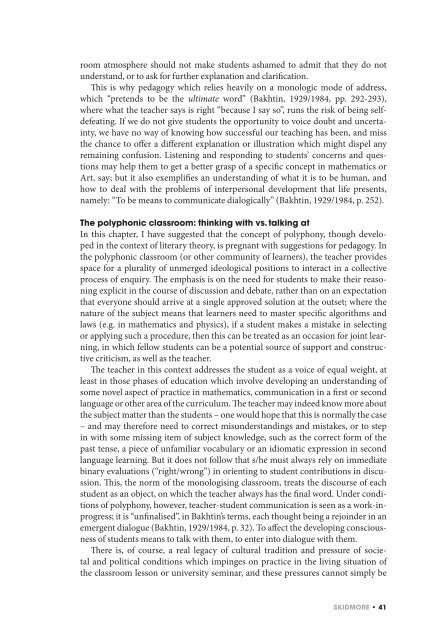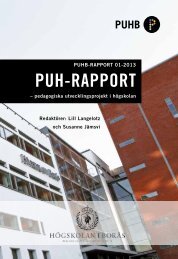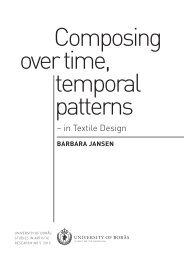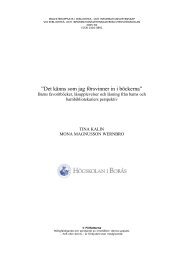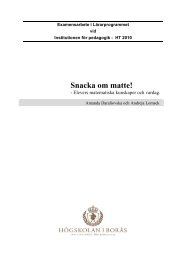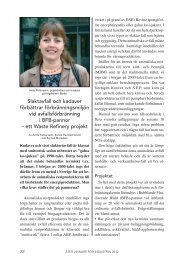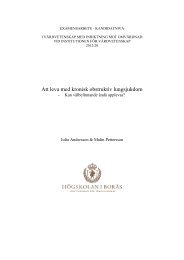Bildning för alla! - DiVA
Bildning för alla! - DiVA
Bildning för alla! - DiVA
Create successful ePaper yourself
Turn your PDF publications into a flip-book with our unique Google optimized e-Paper software.
oom atmosphere should not make students ashamed to admit that they do not<br />
understand, or to ask for further explanation and clarification.<br />
This is why pedagogy which relies heavily on a monologic mode of address,<br />
which “pretends to be the ultimate word” (Bakhtin, 1929/1984, pp. 292-293),<br />
where what the teacher says is right “because I say so”, runs the risk of being selfdefeating.<br />
If we do not give students the opportunity to voice doubt and uncertainty,<br />
we have no way of knowing how successful our teaching has been, and miss<br />
the chance to offer a different explanation or illustration which might dispel any<br />
remaining confusion. Listening and responding to students’ concerns and questions<br />
may help them to get a better grasp of a specific concept in mathematics or<br />
Art, say; but it also exemplifies an understanding of what it is to be human, and<br />
how to deal with the problems of interpersonal development that life presents,<br />
namely: “To be means to communicate dialogically” (Bakhtin, 1929/1984, p. 252).<br />
The polyphonic classroom: thinking with vs. talking at<br />
In this chapter, I have suggested that the concept of polyphony, though developed<br />
in the context of literary theory, is pregnant with suggestions for pedagogy. In<br />
the polyphonic classroom (or other community of learners), the teacher provides<br />
space for a plurality of unmerged ideological positions to interact in a collective<br />
process of enquiry. The emphasis is on the need for students to make their reasoning<br />
explicit in the course of discussion and debate, rather than on an expectation<br />
that everyone should arrive at a single approved solution at the outset; where the<br />
nature of the subject means that learners need to master specific algorithms and<br />
laws (e.g. in mathematics and physics), if a student makes a mistake in selecting<br />
or applying such a procedure, then this can be treated as an occasion for joint learning,<br />
in which fellow students can be a potential source of support and constructive<br />
criticism, as well as the teacher.<br />
The teacher in this context addresses the student as a voice of equal weight, at<br />
least in those phases of education which involve developing an understanding of<br />
some novel aspect of practice in mathematics, communication in a first or second<br />
language or other area of the curriculum. The teacher may indeed know more about<br />
the subject matter than the students – one would hope that this is normally the case<br />
– and may therefore need to correct misunderstandings and mistakes, or to step<br />
in with some missing item of subject knowledge, such as the correct form of the<br />
past tense, a piece of unfamiliar vocabulary or an idiomatic expression in second<br />
language learning. But it does not follow that s/he must always rely on immediate<br />
binary evaluations (“right/wrong”) in orienting to student contributions in discussion.<br />
This, the norm of the monologising classroom, treats the discourse of each<br />
student as an object, on which the teacher always has the final word. Under conditions<br />
of polyphony, however, teacher-student communication is seen as a work-inprogress;<br />
it is “unfinalised”, in Bakhtin’s terms, each thought being a rejoinder in an<br />
emergent dialogue (Bakhtin, 1929/1984, p. 32). To affect the developing consciousness<br />
of students means to talk with them, to enter into dialogue with them.<br />
There is, of course, a real legacy of cultural tradition and pressure of societal<br />
and political conditions which impinges on practice in the living situation of<br />
the classroom lesson or university seminar, and these pressures cannot simply be<br />
SKiDMOre • 41


